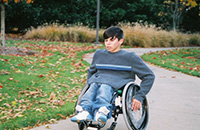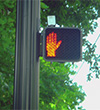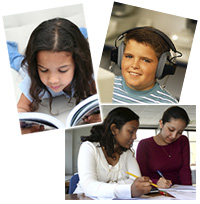How can teachers at Sycamore Middle School meet the educational needs of all of their students?
Page 1: Universal Design for Learning (UDL)
 Today’s classrooms are more diverse than ever. Students see, hear, speak, move, read, write, understand English, organize, engage, and remember in so many different ways. At the same time, current law (e.g., Every Student Succeeds Act [ESSA], Individuals with Disabilities in Education Act, 2004 [IDEA 2004]) and contemporary teaching practices not only expect and encourage education in inclusive settings but they also require evidence of it. The teachers at Sycamore Middle School know that meeting such diverse needs in the classroom is a challenging task.
Today’s classrooms are more diverse than ever. Students see, hear, speak, move, read, write, understand English, organize, engage, and remember in so many different ways. At the same time, current law (e.g., Every Student Succeeds Act [ESSA], Individuals with Disabilities in Education Act, 2004 [IDEA 2004]) and contemporary teaching practices not only expect and encourage education in inclusive settings but they also require evidence of it. The teachers at Sycamore Middle School know that meeting such diverse needs in the classroom is a challenging task.
Every Student Succeeds Act (ESSA)
Federal education law originally enacted in 1965 as the Elementary and Secondary Education Act (ESEA). This law now mandates the use of academic and behavioral evidence-based practices. When this act was reauthorized in 2001, it was referred to as the No Child Left Behind Act (NCLB). The Every Student Succeeds Act (ESSA) reauthorized the Elementary and Secondary Education Act in 2015 and went into effect in the 2017–2018 school year.
Individuals with Disabilities in Education Act, 2004 [IDEA 2004]
Name given in 1990 to the Education for All Handicapped Children Act (EHA) and used for all reauthorizations of the law that guarantees students with disabilities the right to a free appropriate public education in the least-restrictive environment.
Universal Design in Architecture
 In 1990 Congress passed the Americans with Disabilities Act (ADA), a law that prohibits discrimination against persons with disabilities in employment, transportation, public accommodations, and telecommunications. The ADA guarantees individuals with disabilities greater access to participation in the everyday activities enjoyed by those without disabilities. In response, architects developed the principles of universal design to guide the creation of new buildings and tools for living so that they are accessible to as many people as possible, including those with disabilities. Whether we realize it or not, we encounter many examples of universally designed features or products in our daily lives. The seven basic principles of universal design that guide the creation of new buildings and tools for living are described in the table below.
In 1990 Congress passed the Americans with Disabilities Act (ADA), a law that prohibits discrimination against persons with disabilities in employment, transportation, public accommodations, and telecommunications. The ADA guarantees individuals with disabilities greater access to participation in the everyday activities enjoyed by those without disabilities. In response, architects developed the principles of universal design to guide the creation of new buildings and tools for living so that they are accessible to as many people as possible, including those with disabilities. Whether we realize it or not, we encounter many examples of universally designed features or products in our daily lives. The seven basic principles of universal design that guide the creation of new buildings and tools for living are described in the table below.
Americans with Disabilities Act (ADA)
Federal disability anti-discrimination legislation passed in 1990 to guarantee basic civil rights to people with disabilities; similar to those provided to individuals on the basis of race, sex, national origin, and religion, ADA guarantees equal opportunity for individuals in areas of employment, transportation, government services, telecommunications, and public accommodations.
| Principles of Universal Design | ||
| Principle | Description | Example |
| Equitable use | The design is useful and marketable to people with diverse abilities. |  Curb cuts |
| Flexibility of use | The design accommodates a wide range of individual preferences and abilities. |  Tools that can be used by both left- and right-handed people |
| Simple and intuitive | Use of the design is easy to understand, regardless of the user’s experience, knowledge, language skills, or current concentration level. |  Universal symbols |
| Perceptible information | The design communicates necessary information effectively to the user, regardless of ambient conditions or the user’s sensory abilities. |  Crosswalk signal with auditory indicator |
| Tolerance for error | The design minimizes hazards and the adverse consequences of accidental or unintended actions. |  “Are you sure you want to delete this file?” |
| Low physical effort | The design can be used efficiently and comfortably and with a minimum of fatigue. |  Motion sensor to open door |
| Size and space for approach and use | Appropriate size and space is provided for approach, reach, manipulation, and use, regardless of user’s body size, posture, or mobility. |  Wide doorways, low thresholds |
The Center for Universal Design
(Close this panel)
Did You Know?
UDL adapts and applies the ideas and concepts associated with universal design in architecture. The overarching idea of universal design is that buildings and tools should be accessible to everyone—those with and those without disabilities. For example, curb cuts allow people who use wheelchairs to move freely and independently from sidewalks to streets or parking lots. At the same time, they benefit people who use strollers, shopping carts, scooters, and skateboards.
To meet the needs of all students in the general education classroom to the greatest extent possible, a team of Sycamore Middle School personnel convenes to research and evaluate potential approaches. They discover Universal Design for Learning (UDL), which appears to meet their needs. UDL provides a research-based framework for teachers to incorporate flexible materials, techniques, and strategies for delivering instruction and for students to demonstrate their knowledge in a variety of ways. Developed by researchers at the Center for Applied Special Technology (CAST), this framework stands in contrast with the “one size fits all” instructional approach that has traditionally been used in classrooms, as outlined in the table below.
| Traditional Instruction | Universal Design for Learning Instruction |
|
|
Adapted from Universal Design for Learning: A Guide for Teachers and Education Professionals.
CAST is an organization that primarily conducts research related to Universal Design for Learning. Listen as David Rose, a founder of CAST, and Grace Meo, formerly of CAST, describe UDL.

Grace Meo
Former CAST Director of Professional
Development & Outreach Services
(time: 0:24)
Transcript: David Rose
UDL is a framework for teaching and learning. It assumes from the beginning that learners are very different. The design part of universal design is designing a learning environment that is as diverse as the students are. There’s many options for how to learn within it. So the idea of Universal Design for Learning is to create good learning environments that work across a wide spectrum of students.
Transcript: Transcript: Grace Meo
In addition to thinking about the diversity of students, the focus of UDL is to really engage all students in learning and to support all individuals to gain knowledge and to gain skills in learning. So UDL is a framework for learning but focusing on engaging, building knowledge and skills, and ensuring an enthusiasm for learning.
The primary reason the Sycamore team favors UDL is that it addresses the educational needs of all students: average learners, English learners, students who have received poor instruction in the past, students with learning disabilities, students with sensory and motor challenges, and gifted and talented students, among others. UDL benefits all students by:
 Meeting the needs of the widest range of students by reducing the number of barriers to learning
Meeting the needs of the widest range of students by reducing the number of barriers to learning- Providing challenging, salient, and age-appropriate materials to students with a range of abilities
- Allowing students to learn in accordance with their learning preferences
- Creating alternative ways for students to both receive and deliver information
Learning Preference
Learning preference refers to the mode by which a person prefers to learn or process information. The four primary learning modalities (i.e., sensory modalities) are visual, auditory, tactile, and kinesthetic.
 |
 |
 |
 |
|
Visual Learners: remember what they see and benefit from visual aids such as charts, diagrams, and maps |
Auditory Learners: learn through lectures and class discussions and do well at following oral instructions |
Kinesthetic Learners: benefit from movement activities that require them to use their bodies |
Tactile Learners: prefer to learn through tactile or hands-on activities |
Listen as David Rose discusses the benefits of UDL (time: 1:27).

David Rose
CAST founder; Chief Scientist,
Cognition & Learning
Transcript: David Rose
The benefits of Universal Design for Learning are higher achievement across the full spectrum of students. Sometimes, people think that Universal Design for Learning is primary for students with disabilities or English language learners, students who are struggling in the classroom. But when Universal Design for Learning is done well, it actually provides just the right challenge and just the right support for students throughout the classroom, including students who are gifted and talented, students who are average in most respects, and students who have disabilities. There’s three kinds of benefits of UDL. First, the benefit of UDL for students is that there are many ways to succeed, and the fact that there are many ways to succeed means that students can be engaged, can make rapid progress and feel like competent learners. The real goal is that, by the end of their schooling, they’ll be expert learners. Two, there are benefits for teachers. What UDL does is provide ways for teachers to succeed as well. And, thirdly, the benefits of UDL for administrator is that there’s more ways to support teachers in doing a good job that are not cost ineffective.
Activity
Be aware that research does not support the “learning styles” theory that students learn better when they are taught via preferred modalities. In other words, there is no evidence that, for example, visual learners show greater learning gains when taught using visual means.
However, the use of preferred modalities can improve engagement and reduce barriers for some students (e.g., those with disabilities, English language learners).
Teachers, like students, have preferences regarding the ways in which they like to learn. In fact, teachers’ learning preferences often influence their teaching methods. For example, a teacher who prefers to learn through auditory means might tend to present information through lectures and discussions, a decision that might prove disadvantageous for students who have difficulty grasping information this way (e.g, students with auditory processing difficulties, English language learners). Remember that it is helpful for both teachers and students to be aware of their learning preferences. Click here to assess your preferred learning modality using the Barsch Inventory.